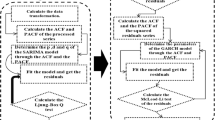Abstract
Seasonal Auto Regressive Integrative Moving Average models (SARIMA) were developed for monthly, weekly and daily monsoon rainfall time series. Using Box-Cox transformation and subsequently differencing, monthly, weekly and daily monsoon rainfall time series were made stationary. The best SARIMA models were selected based on the autocorrelation function (ACF) and partial autocorrelation function (PACF), and the minimum values of Akaike Information Criterion (AIC) and Schwarz Bayseian Information (SBC). As per Ljung-Box Q statistics, residuals were random in nature and there was no need for further modelling. Performance and validation of the SARIMA models were evaluated based on various statistical measures. The mean and standard deviation of the predicted data were found close to the observed data. Nash-Sutcliffe coefficient also indicated a high degree of model fitness to the observed data. Forecasting of monthly, weekly, daily monsoon time series for 14 years, i.e., from 2014 to 2027 was done using the developed SARIMA models.



























Similar content being viewed by others
References
Akpanta AC, Okorie IE, Okoye NN (2015) SARIMA modelling of the frequency of monthly rainfall in Umuahia, Abia state of Nigeria. Am J Math Stat 5(2):82–87
Altendorf CT, Elliot RI, Stevens EW, Stone MI (1999) Development and validation of a neural network model for soil water content predictions with comparison to regression techniques. Trans Am Soc Agric Eng 43(3):691–699
Asklany SA, Elhelow K, Youssef IK, Abd El-wahab M (2011) Rainfall events prediction using rule-based fuzzy inference system. Atmos Res 101:228–236
Bockwell PJ, Davis RA (1991) Time series: theory and methods, 2nd Edition. Springer, New York
Box GEP, Jenkins GM, Bacon DW (1967) Models for forecasting seasonal and non-seasonal time series. In: Harris B (ed) Spectral analysis of time series. John Wiley & Sons, Inc., New York
Burian SJ (2000) Rainfall disaggregation using artificial networks. J Hydrol Eng 5(3):229–307
Chang X, Gao M, Wang Y, Hou X (2012) Seasonal autoregressive integrated moving average (SARIMA) model for precipitation time series. J Math Stat 8(4):500–505
Dabral PP, Jhajharia D, Mishra P, Hangshing L, Doley BJ (2014) Time series modelling of pan evaporation: a case study in the northeast India. Global NEST J 16(2):280–292
Dabral PP, Pandey A, Baithuri N, Mal BC (2008) Stochastic modelling of rainfall in humid region of north east India. Water Resour Manag 22:1395–1407
Dabral PP, Saring T, Jhajharia D (2016) Time series models of monthly rainfall and temperature to detect climate change for Jorhat (Assam), India. Global NEST J 18(3):494–507
Duhan D, Pandey A (2015) Statistical downscaling of temperature using three techniques in the tons river basin in central India. Theor Appl Climatol 121(3–4):606–622
Engle RF (1982) Autoregressive conditional heteroscedasticity with estimates of variance of UK inflation. Econometrica 50:987–1007
Hangshing L (2014) Time series modelling of rainfall for Doimukh (Itanagar), Arunachal Pradesh. An unpublished M. Tech. (soil and water conservation engineering) thesis of Department of Agricultural Engineering, NERIST, Nirjuli-791109, Arunachal Pradesh (India)
Hassan HM, Mohamed TM (2014). Rainfall drought simulating using stochastic SARIMA models for Gadaref region, Sudan. Munich personal RePEc Archive, MPRA- 61153
Hipel KW, McLeod AI (1994) Time series modelling of water resources and environmental systems. Elsevier, Amsterdam
Jain A, Srinivasulu S (2004) Development of effective and efficient rainfall runoff models using integration of deterministic, real coded genetic algorithms and artificial neural techniques. Wat Resour Res 40:1–2
Ljung GM, Box GEP (1978) On a measure of lack of fit in time series models. Biomerika 65:297–303
Mehta R, Jain SK, Vipin K (2005) Fuzzy technique for reservoir operation effect of membership function with different number of categories. Hydro J 28(3–4):17–33
Meshram DT, Gorantiwar SD, Mittal HK, Jain HK (2015) Forecasting of pomegranate (Punica granatum L.) evapotranspiration by using seasonal ARIMA model. Indian J Soil Conserv 43(1):38–46
Mishra AK, Desai VR (2005) Drought forecasting using stochastic models. Stoch Env Res Risk Assess 19:326–339
Modareres R (2007) Streamflow drought time series forecasting. Stoch Env Res Risk A 21:223–233
Mukesh K, Devendra K (2010) Multiplicative ARIMA modelling of monthly stream flows of Betwa river. Indian J Soil Conserv 38(2):62–68
Nirmala M, Sundaram SM (2010) A seasonal ARIMA model for forecasting monthly rainfall in Tamilnadu. Natl J Adv Build Sci Mech 1(2):43–47
Raman H, Sunilkumar N (1995) Multivariate modelling of water of water resources time series using ANN. Hydrol Sci J 40(2):145–163
Salas JD, Dellur JW, Yevjevich V, Lane WL (1980) Applied modelling of hydrological time series. Water Resources Publication, Littleton, p 484
Shirgure PS, Rajput GS (2014) Modelling daily pan evaporation using artificial neural networks. Indian J Soil Conserv 42(2):119–129
Tripura H (2014). Hybrid SARIMA-GARCH modelling of monthly rainfall time series. An unpublished M. Tech (soil and water conservation engineering) thesis of Department of Agricultural Engineering, NERIST, Nirjuli-791109, Arunachal Pradesh (India)
Walker GT (1931) On periodicity in series of related terms. Proc R Soc A 131:518
Wong KW, Wong PM, Gedeon TD, Fung CC (2003) Rainfall prediction model using soft computing technique. Soft Comput 7(6):434–438
Yule GW (1927) On a method of investigating periodicities in distributed series with special reference to Wolfoers’s sunspot number. Phil Trans A 226:267
Yusof F, Kane IL (2012) Modelling monthly rainfall time series using ETS state space and SARIMA models. Int J Curr Res 4(9):195–200
Zang M, Scofield AR (1994) Artificial neural network techniques for estimating rainfall and recognizing cloud merger from satellite data. Int J Remote Sens 16:3241–3262
Author information
Authors and Affiliations
Corresponding author
Rights and permissions
About this article
Cite this article
Dabral, P.P., Murry, M.Z. Modelling and Forecasting of Rainfall Time Series Using SARIMA. Environ. Process. 4, 399–419 (2017). https://doi.org/10.1007/s40710-017-0226-y
Received:
Accepted:
Published:
Issue Date:
DOI: https://doi.org/10.1007/s40710-017-0226-y




